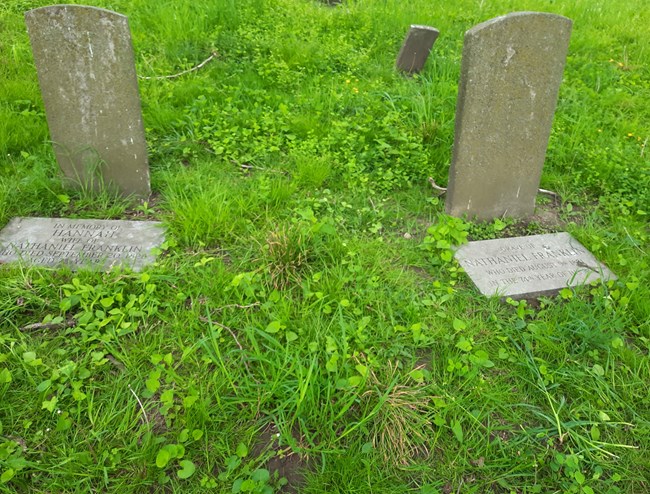Last updated: January 17, 2025
Article
A long road to freedom: Nathaniel & Hannah Franklin and the American Revolution

NPS
Nathaniel & Hannah Franklin and the American Revolution
The trajectory of the lives of Nathaniel and Hannah Franklin, formerly enslaved Black people who are buried in the historic cemetery at St. Paul’s, was influenced by the achievements of the American Revolution. But the delay in their emancipation was the apparent result of a wealthy widow’s reluctance to part with their service.
Born in the 1750s, Hannah and Nathaniel were enslaved to the Franklins, a wealthy family living in Eastchester, New York, the parish of St. Paul’s, a small farming village about 20 miles north of New York City. They were unfortunately part of a broad pattern of slavery in colonial New York, including Eastchester, where about 15-percent of the population were enslaved Africans. Many wealthy local families owned small numbers of enslaved people, who were used as farm laborers and domestic servants.
The Revolutionary War had a significant impact on the lives of thousands of African Americans, including in the local community, but not, apparently on Nat and Hannah’s lives. The St. Paul’s area was part of a contested ground, characterized by British positions south of the church and strong American positions north of the town. No organized governmental apparatus was in place. Small skirmishes and raids on civilians were common. In this setting, where traditional lines of authority and control were loosened, many enslaved people gained their freedom. Anna Ward, for instance, a young mother of about 25, enslaved on a farm near the Franklins, escaped to British lines with her child early in the war. She eventually joined the Loyalist exodus to Canada when the British evacuated New York City at the conclusion of the war in 1783.
Some of the informal local histories record that Nathaniel Franklin served in the Revolutionary War, but there is no documentation of the specific nature of his service. James Franklin served in the Westchester County militia, and it is possible that Nathaniel, who was 19 in 1776, could have accompanied James into the service. Or, he may have helped procure supplies for the American forces. What is clear is that Nat and Hannah remained enslaved at the end of the war.
Influenced by the ideals of the American Revolution, many Northern states moved to eliminate slavery in the decades following independence. Some of these states, like Vermont and Pennsylvania, enacted immediate emancipation laws, while New York and New Jersey structured gradual emancipation plans. Nat and Hannah were eventually affected by this trend, but it took a long time.
There are numerous indications that the married couple had a special relationship with the Franklin family. In 1793, James Franklin noted in his will that his:
"Loving wife Glorianna caused to be raised out of my Estate the sum of 50 pounds which I give to my Negro woman Hannah and my Negro man Nat and I order that the same be laid out for their use and benefit for ever in purchasing a house or land … as shall generally be thought most for their advantage."
Upon the death of James, Glorianna emerged as the owner of Nat and Hannah, along with considerable real estate holdings in Westchester County and New York City. America still observed the British tradition of coverture, which meant a married woman surrendered property rights to her husband, but single or widowed women could legally own property. By the early 1800s, Glorianna was also the largest enslaver in the town, owning ten enslaved people. Nat and Hannah remained enslaved for another 30 years, even though the cruel system of human bondage was slowly collapsing around them.
New York passed gradual emancipation in 1799, which required that children subsequently born to an enslaved woman would achieve freedom upon reaching maturity, in their 20s. But the law initiated a process of ending slavery. Because the end of bondage was in sight, many enslavers were amenable to manumissions. The censuses of 1810 and 1820 record a significant increase in the number of free black people in the town, and a considerable decrease in the number of enslaved black people. Even Glorianna Franklin was manumitting the enslaved on her farm, including a woman named Rebecca Turner, whose remarkable life is described in another article on this website.
How did Nat and Hannah feel as most of the other enslaved Black people around them gained their freedom, and they remained enslaved? We can never know since their voices on this matter are absent from the historical record. But their special relationship to the Franklin family endured. Glorianna wrote a lengthy will in 1810, perhaps because she possessed an abundance of property. Bequeathments to Nat and Hannah are heavily represented in the testament, including animals, farm equipment, clothing, furnishings, and an array of household goods. There is even “the sum of seven hundred and fifty dollars to be laid out by my executors in purchasing a farm for them the conveyance for the same.”
But that 1810 document stipulated that the conveyance of those emoluments would occur upon Glorianna’s death, and she lived another 13 years, through 1823.
An additional emancipation law passed by New York in 1817 stipulated that slavery would end in the state on July 4, 1827. In the census of 1820, there were 20 enslaved people left in the town, down from 107 in 1800, and Nat and Hannah were among those 20. It was probably down to single digits by the time the married couple, both well along in life, achieved their freedom in 1824.
After all those years of “faithful service,” Hannah lived another four years in freedom, passing away at age 72 in 1828, and Nathaniel lived three more years, until age 74, through 1831.
It is hard to escape the conclusion that their “faithful service” was an unfortunate circumstance, which ironically perpetuated their enslavement until their enslaver passed away.
